Are you planning to add new, colorful houseplants to your indoor garden but also want them to have some red in their leaves?
Deciding on the correct one can be tricky as there are a lot of popular varieties of houseplants with bright and vivid leaf colors.
Considering if they’re a low-maintenance plant and the location will help in making the decision as to which magnificent houseplant is the best fit for your indoor garden.
And of course, we can’t forget the striking features, brilliant shades, and aesthetics that the plant type will bring into your home.
- Related article: Houseplant Lists
Nevertheless, no need to worry! We took a look at some of the best and most popular houseplants with reddish leaves for your indoor garden!
1. Aglaonema Valentine (Aglaonema Commutatum)
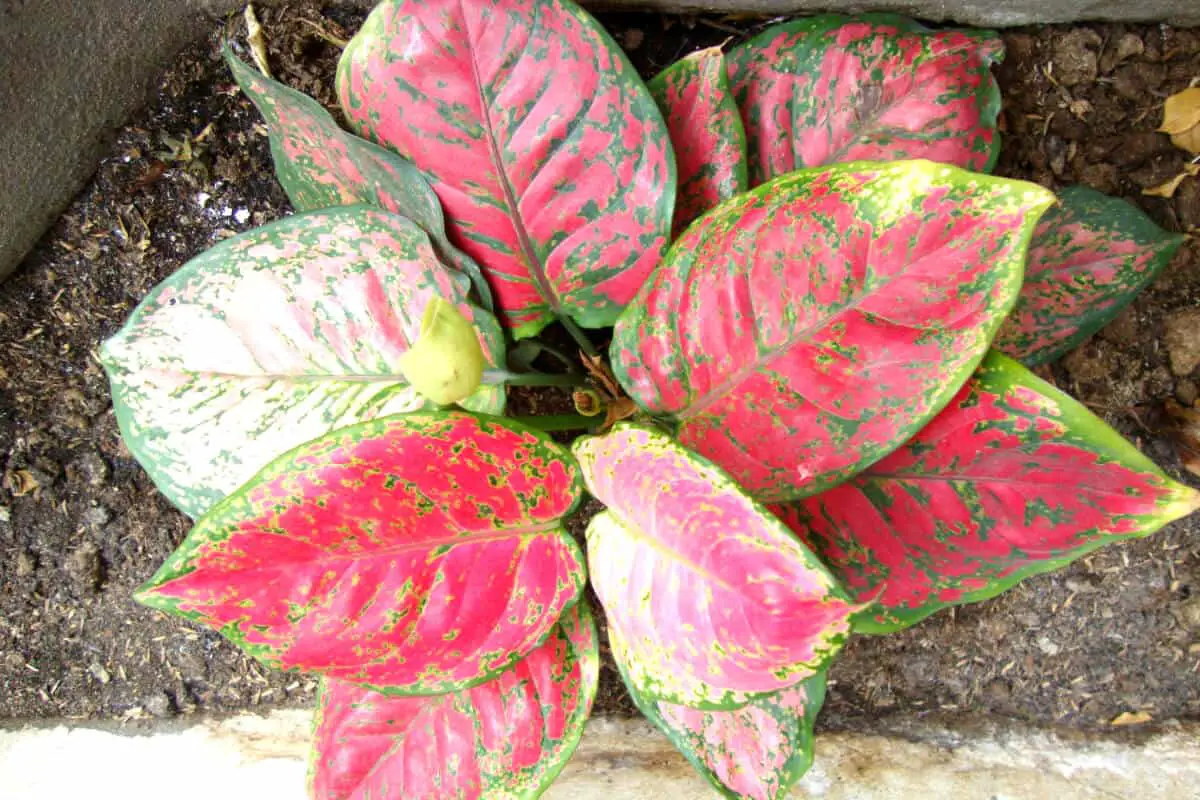
The Aglaonema plant, or Chinese Evergreen plant, is a perennial plant type that is native to the Asian subtropics and is a great choice for anyone looking for a bold, vibrant addition to their home.
It has large, glossy, green, oval-shaped leaves and bright, red veins and pink colors emanating from the middle of the leaves, which add a dramatic look to any interior space.
In terms of maintenance, the Aglaonema is fairly low-maintenance and requires minimal care.
When it comes to watering, the Aglaonema should be watered once a week and the pot should be allowed to dry out between waterings.
Like most indoor plants, the Aglaonema doesn’t grow well in direct sunlight as it prefers partial shade with strong ambient light and moist soil conditions.
Pruning and repotting can also be done if necessary.
Surprisingly, this plant does more than just add some color to your home as it’s been included in NASA’s list of air-purifying plants!
Lastly, it’s also considered a Good-Luck Plant by Feng Shui.
2. Burgundy Ficus (Ficus Elastica ‘Burgundy’)
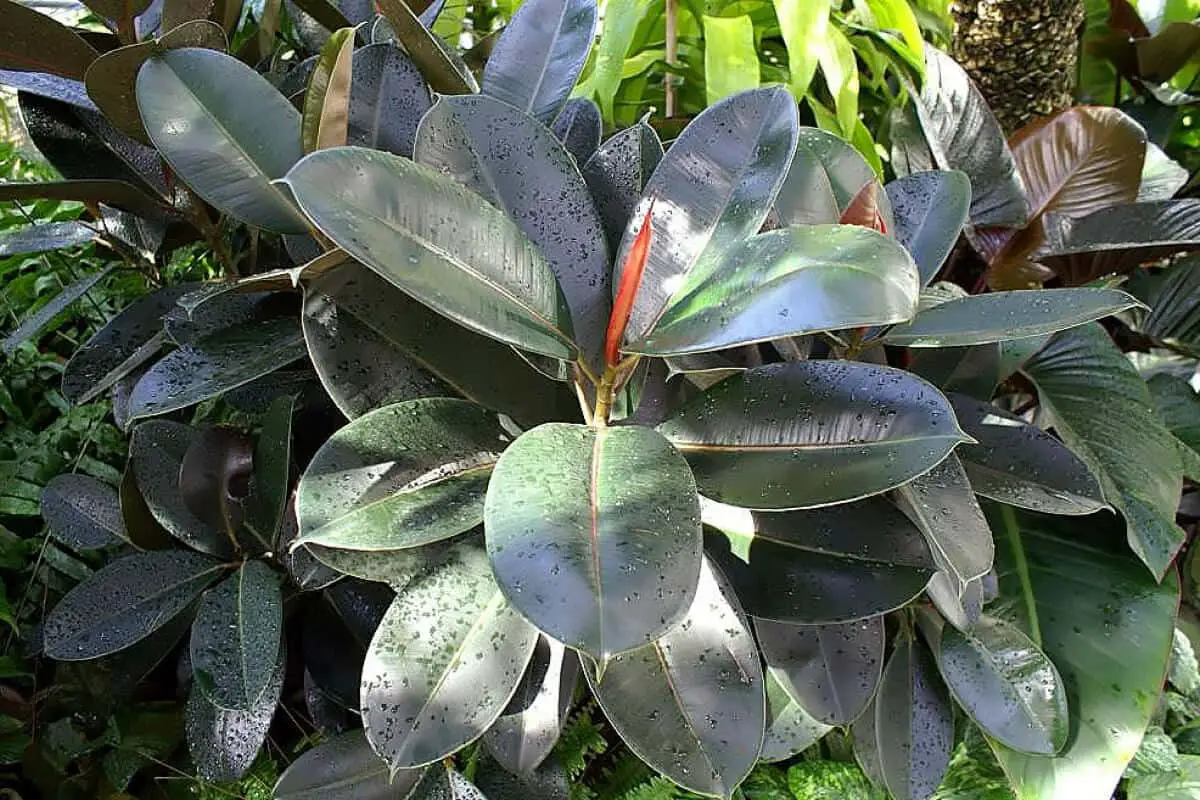
The Burgundy Ficus is an excellent choice for those seeking to brighten up any room with a pop of red as this plant has a unique look and is sure to draw attention.
Burgundy Ficus, otherwise known as the ‘Rubber Plant’, has green and fleshy leaves that are lined with red veins. This color changes as the plant matures.
Additionally, the Burgundy Ficus is also fairly low-maintenance and requires minimal care.
This plant type can withstand limited amounts of direct morning sunlight but prefers bright rooms that provide indirect light.
The Burgundy Ficus will require a moderate amount of water and grows best in moist, well-draining soil.
This plant generally can withstand moderate household levels of humidity. If you have lower levels of humidity, add a pebble tray or humidifier to the room.
3. Florida Sweetheart (Caladium Bicolor)
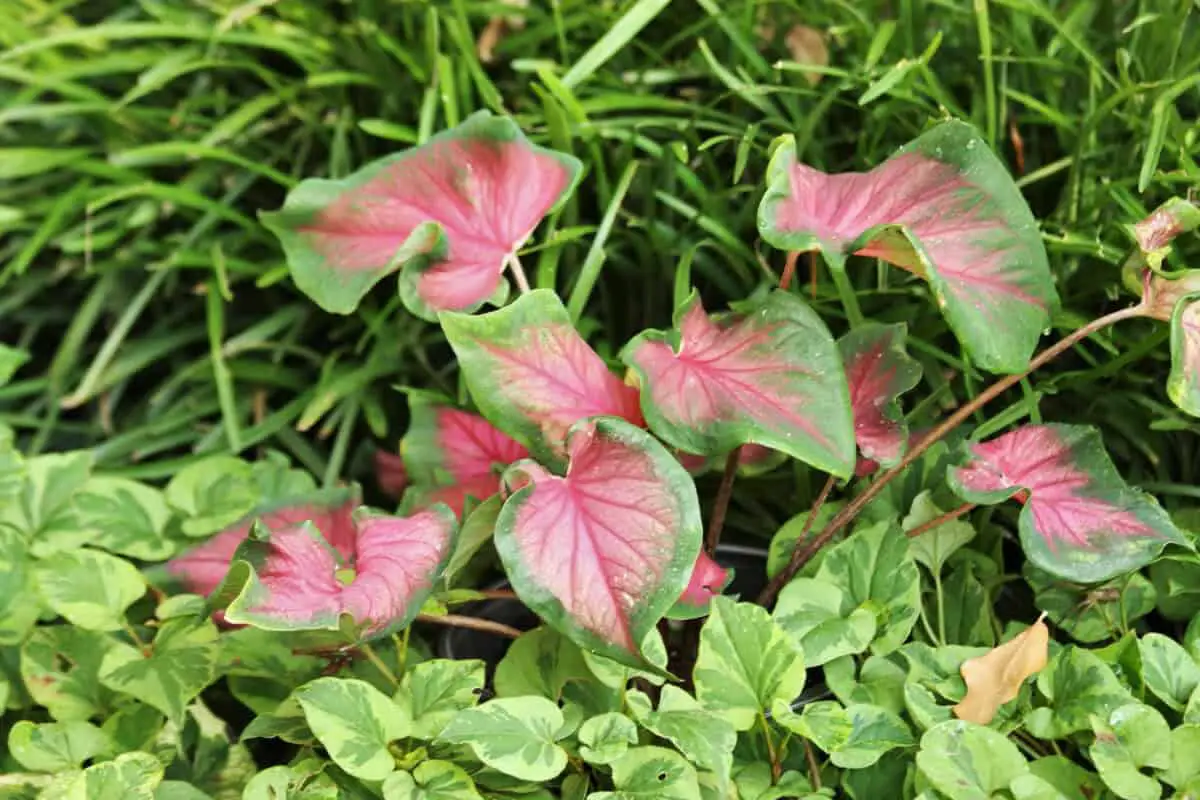
The Florida Sweetheart, also known as the ‘Flaming Sword’ because of its bright red foliage, has elephant ear-shaped, rosy red leaves, with smooth green edges.
These plants are grown from hanging features or containers that provide excellent drainage, but it can also be grown in a pot.
The Florida Sweetheart is ideal for beginners, as it’s easy to care for as long as you provide it with well-draining soil and a touch of warmth.
The Florida Sweetheart needs to be watered regularly and it’s advised to add mulch or straw to the soil.
Also, find a bright room that has plenty of indirect sunlight as this plant can handle a few hours of direct sunlight per day.
Place these plants in warmer areas of your indoor garden, as they don’t like a cold breeze.
This beautiful plant with its red leaves will surely add a pop of color to your home!
4. Emerald Ripple Pepper (Peperomia Caperata)
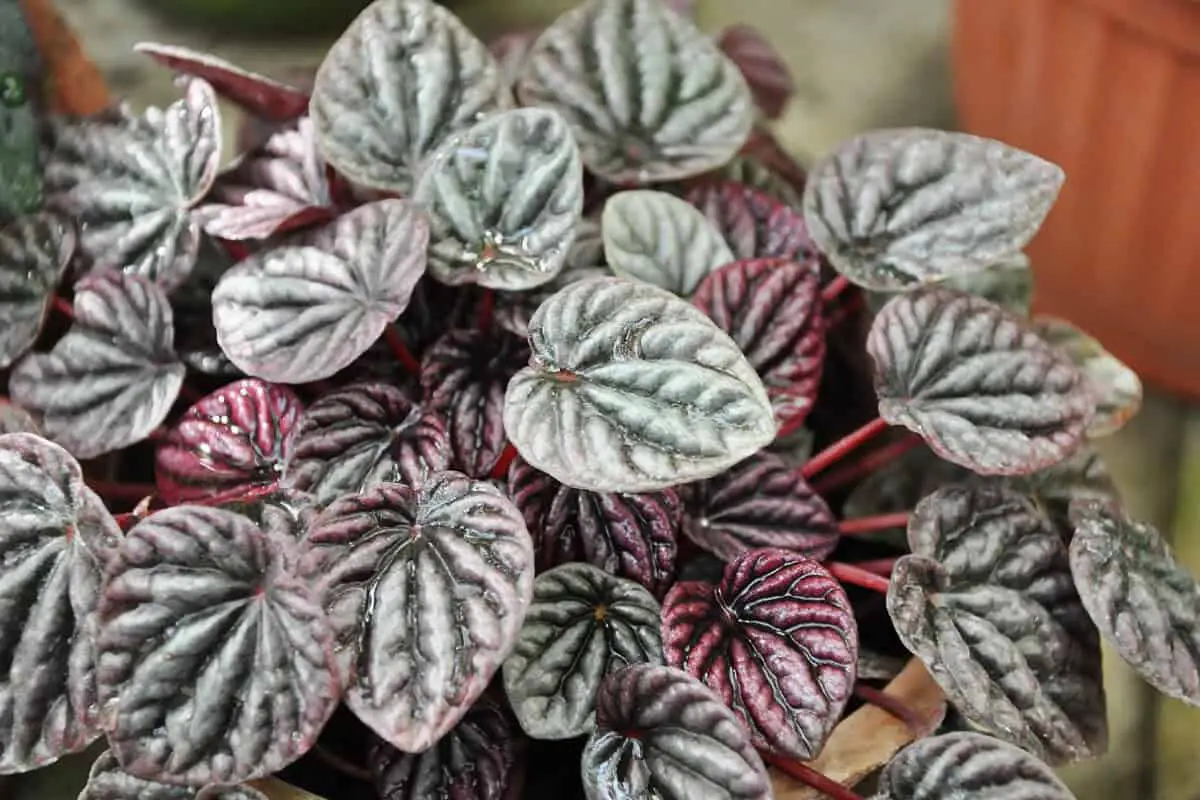
The Emerald Ripple Pepper has heart-shaped emerald-rich veined and wrinkled leaves, which is a little similar in resemblance to a pepper plant.
This plant is a suitable option for those who enjoy houseplants with attractive foliage and low-maintenance requirements.
It features beautiful leaves and delicate flowers, adding a touch of elegance to any home.
You would need to fertilize your plant with a balanced fertilizer every couple of months to ensure it stays healthy for maintenance.
These plants also need sufficient amounts of ambient light to grow and poor lighting conditions will force the plant to stop growing altogether.
However, direct sunlight must be avoided as it will burn the sensitive red leaves of the plant.
Allow half of its soil to dry out in your planting container before rehydrating your plant. It’s best to water these plants from the bottom as keeping water off their leaves will avoid disease.
When in bloom, this plant has flowers that are particularly tiny and grow in clusters, which makes it more appealing for any home.
5. Imperial Red (Philodendron Erubescens)

The Imperial Red is native to the forests of southern America.
This plant has shiny and wide, oval-shaped leaves, with a dramatic shade of green and red, and can be an eye-catching addition to any home or office space.
The Imperial Red Philodendron is a great option for adding a splash of color to any room, especially when the plant is smaller, it’s the obvious choice for a coffee table plant!
However, when the plant grows rather large, it will make for an excellent floor plant.
Indirect sunlight and warm temperatures are what this plant needs.
It also needs to be kept away from animals or young children due to its toxicity, despite its pretty appearance.
Learn more about Philodendron Plants as Houseplants.
6. Fittonia (Fittonia Albivenis)
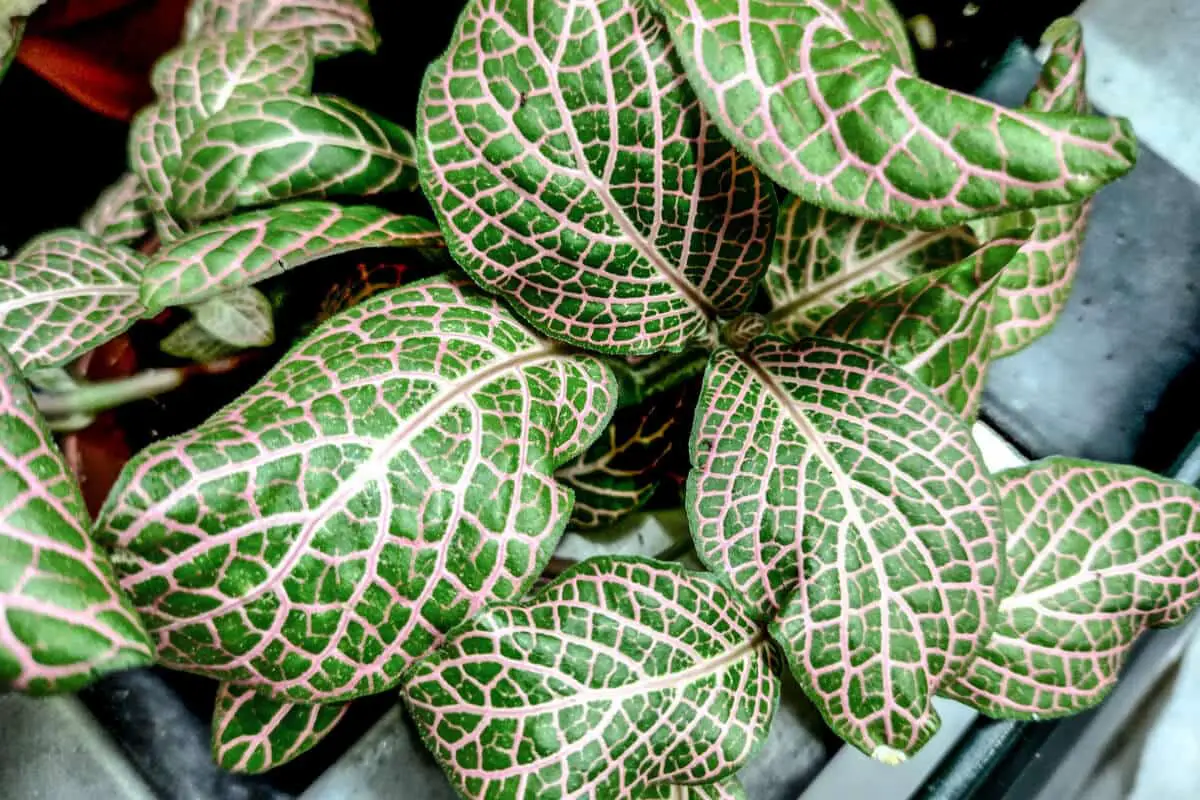
The Fittonia plant, often referred to as Nerve Plant because of the red veins on its leaves, is an evergreen perennial plant.
This plant is an amazing home décor addition because its foliage is vibrant and eye-catching.
The leaves of the Fittonia plant are deep green with a subtle shade of red or pinkish vein pattern running through them.
These plants are especially well suited for indoor planting as they are rather tiny and have a compact size, growing only up to 0.5 feet tall, but can spread over 18 inches in width.
Additionally, they do not need a lot of light and can thrive in most households. These plants only need partial sunlight and grow best in moist soil with good drainage.
The Fittonia plant rarely blossoms, but when it reaches maturity, it has reddish or yellow, small flower spikes.
7. Lance-Leaf Caladium (Caladium ‘Lance Whorton’)
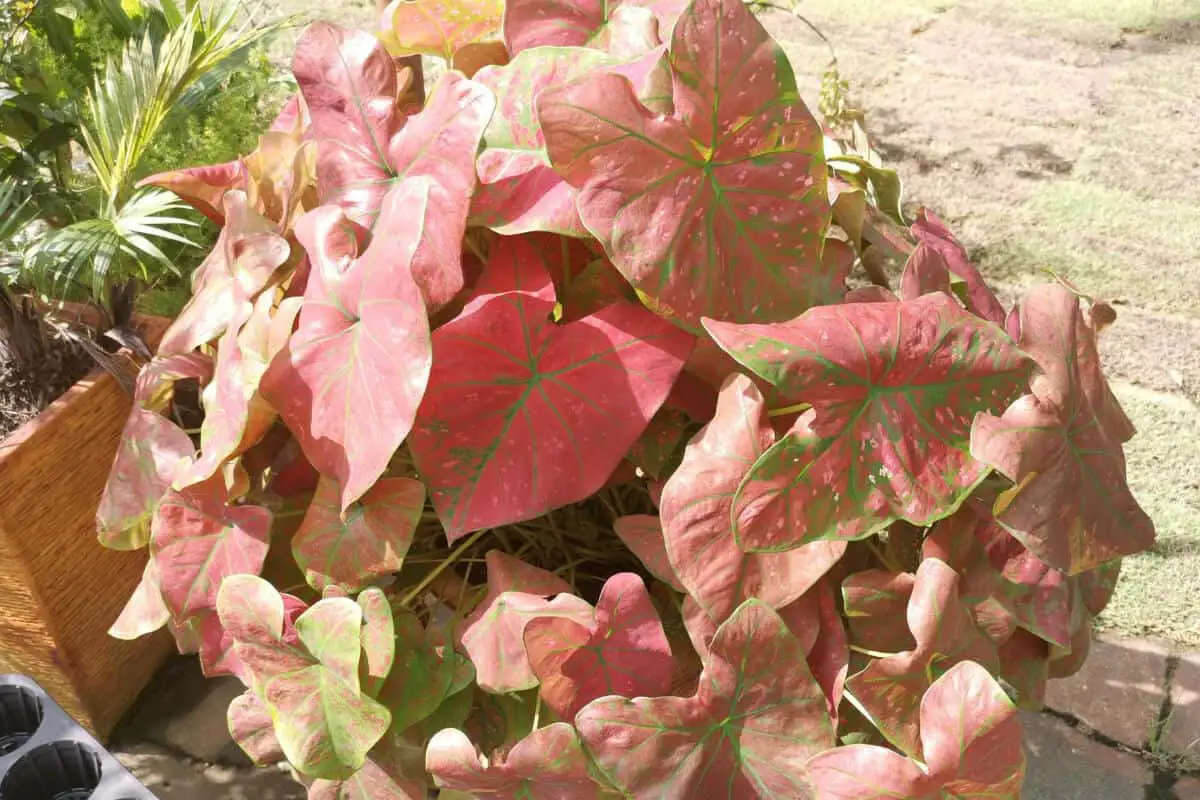
The Lance-leaf Caladium is an ideal houseplant for anyone looking to add a touch of color to their home as its bright, red leaves will make any room more vibrant and inviting.
Additionally, it has heart-shaped leaves and can grow to lengths between 13-17 inches!
The plant is also low maintenance, meaning it won’t require too much attention or effort to keep it healthy.
These plants don’t require large amounts of water and often grow in hanging pot plants or features.
The Lance-leaf Caladium also prefers to grow in well-shaded areas with morning sunlight.
Try to avoid exposing the plant to cooler temperatures. Although it likes shade, it doesn’t do well in cold environments.
Additionally, the Lance-leaf Caladium is known for being an air-filtering plant.
8. Hippo Red Polka Dot Plant (Hypoestes Phyllostachya)
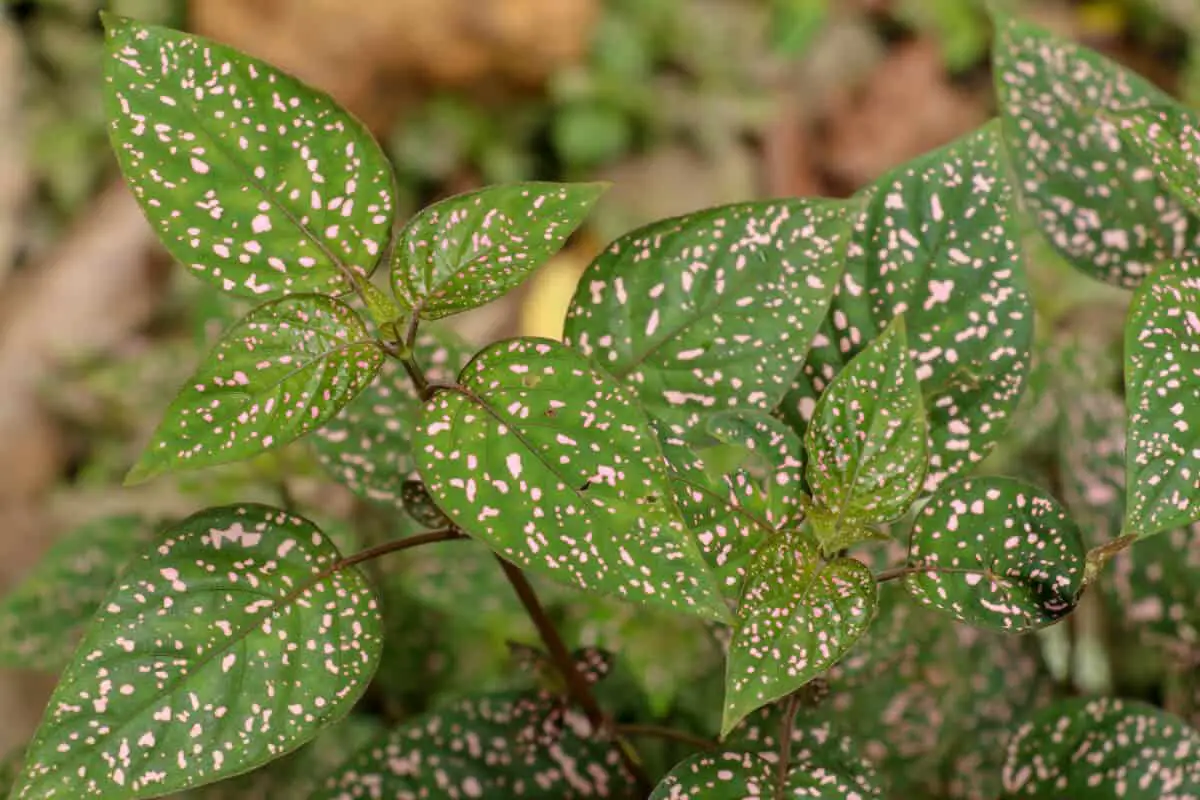
The Hippo Red Polka Dot plant is an excellent choice for those looking to add a few touches of red and green to their home as this plant has heart-shaped speckled red and green leaves.
This plant is low-maintenance and can add some vitality to a room without much concern.
It is recommended to prune this plant regularly as it can grow up to one and a half feet tall.
The Hippo Red Polka Dot plant naturally grows under tree canopies and prefers partial shade in their growing areas.
It’s best grown in warm areas of a household and requires high levels of humidity.
9. Poinsettia (Euphorbia Pulcherrima)
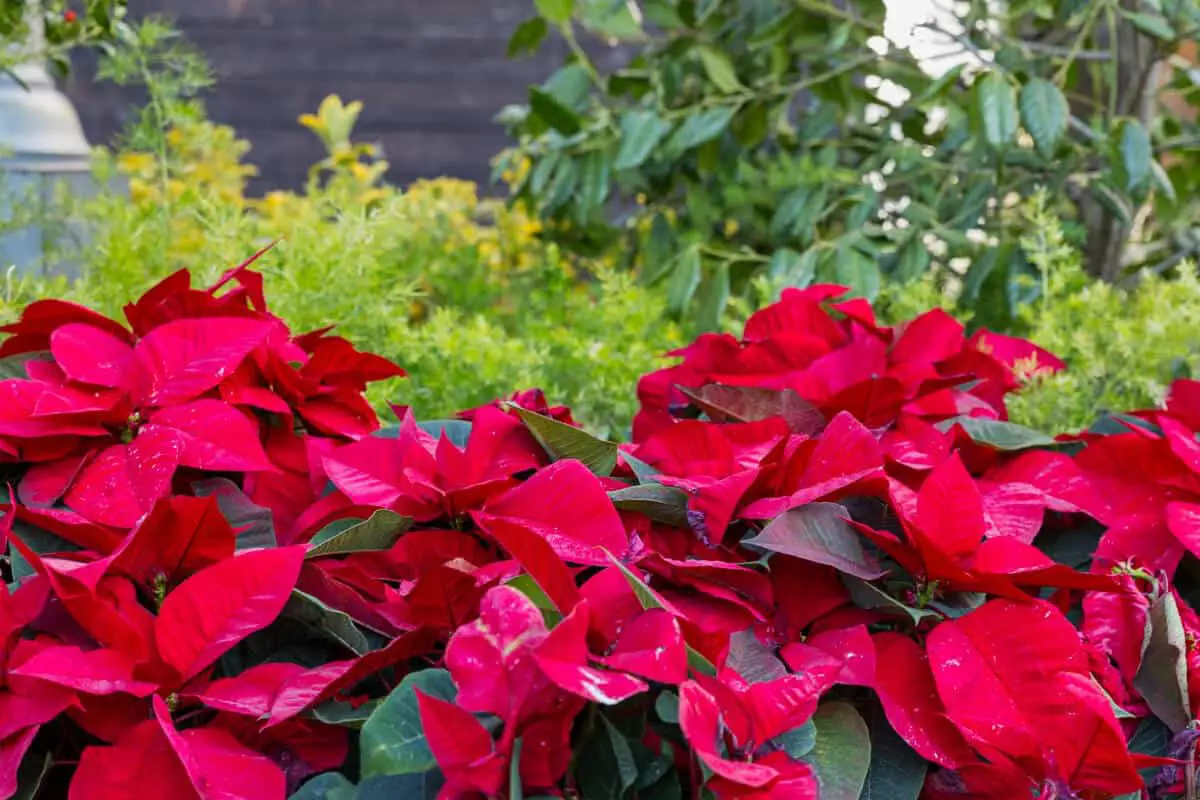
Poinsettia plants are a great addition to any home as they provide a pop of color and festive cheer.
Commonly referred to as the ‘Christmas Plant’ as during the Christmas period, or the start of winter, the plant will produce bright red leaves.
However, its leaves will stay in a bright shade of red all-year round if given the right environment to grow in!
Poinsettia plants require a lot of light and should be placed in an area with indirect light or partial shade.
The soil should be kept moist but not soggy so make sure to water the plant thoroughly when the top inch of soil feels dry, but never overwater.
Place your poinsettia away from any drafts or cold areas as it does not like temperatures below 55 degrees Fahrenheit.
Reduce fertilizing to once a month during the winter months from every two weeks during the summer months using a balanced liquid fertilizer.
Trim off dead leaves and stems as needed to keep your plant looking healthy and vibrant.
This plant possesses air-purifying properties, which make it a suitable indoor plant that can improve the colors and air quality of your home.
10. Revelation Maroon Begonia (Begonia Rex-Cultorum)
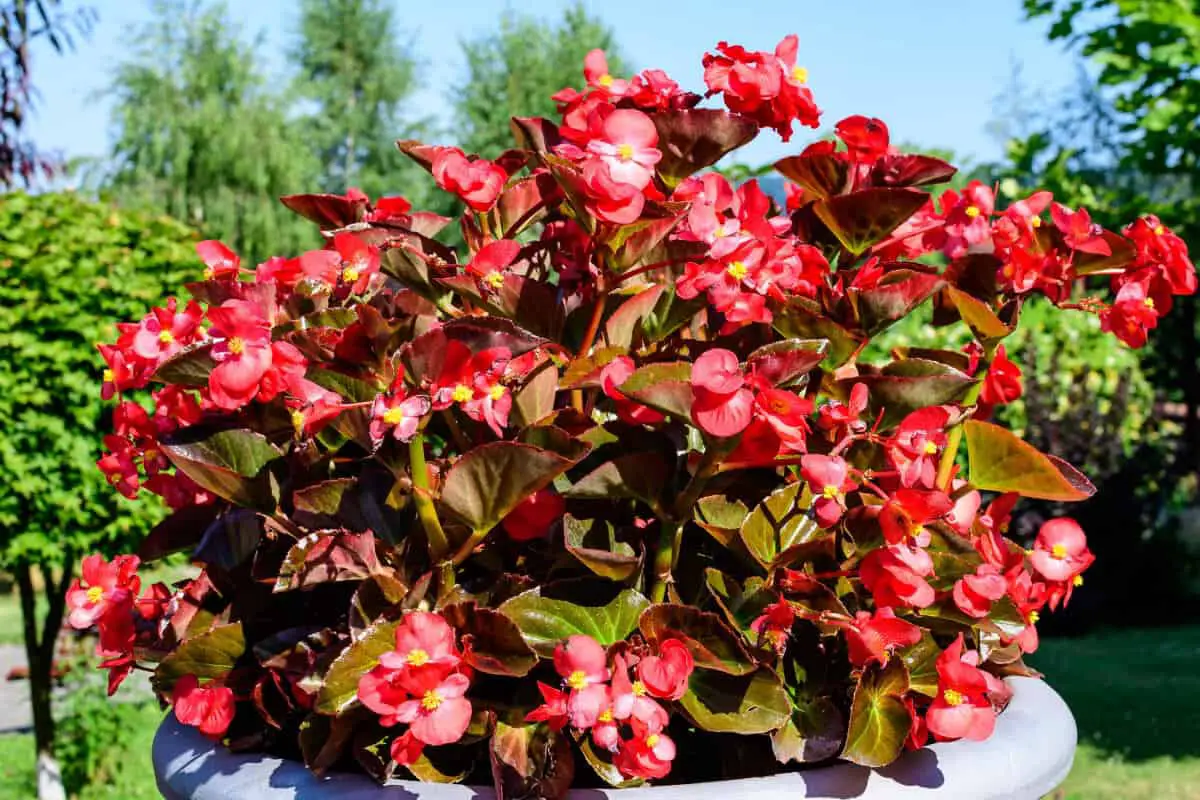
A Revelation Maroon Begonia plant is an ideal houseplant for adding a vibrant pop of color to any home with its beautiful shade of deep red rose, with a touch of dark olive green leaves.
When in blossom, the plant has wonderful pink flowers.
It’s also relatively low-maintenance, but there are a few tips that will help you keep your plant looking its best.
First, Revelation Maroon Begonias prefer bright, indirect light and should be placed in an area with plenty of filtered sunlight or partial shade.
Also, keep the soil moist but not wet at all times and water thoroughly when the top inch of soil is dry.
During the summer months, it’s important to fertilize your begonia every two weeks using a balanced liquid fertilizer and reduce fertilization to once per month during the winter months.
Be sure to prune off any dead or yellowing leaves as needed and keep away from cold drafty areas as they do not tolerate temperatures below 55 degrees Fahrenheit.
Additionally, try misting your plant regularly with lukewarm water to increase humidity levels as these plants prefer high humidity levels.
Lastly, be sure to check for pests such as aphids or spider mites and remove them if found.
11. Ruby Ficus (Ficus Elastica ‘Ruby’)
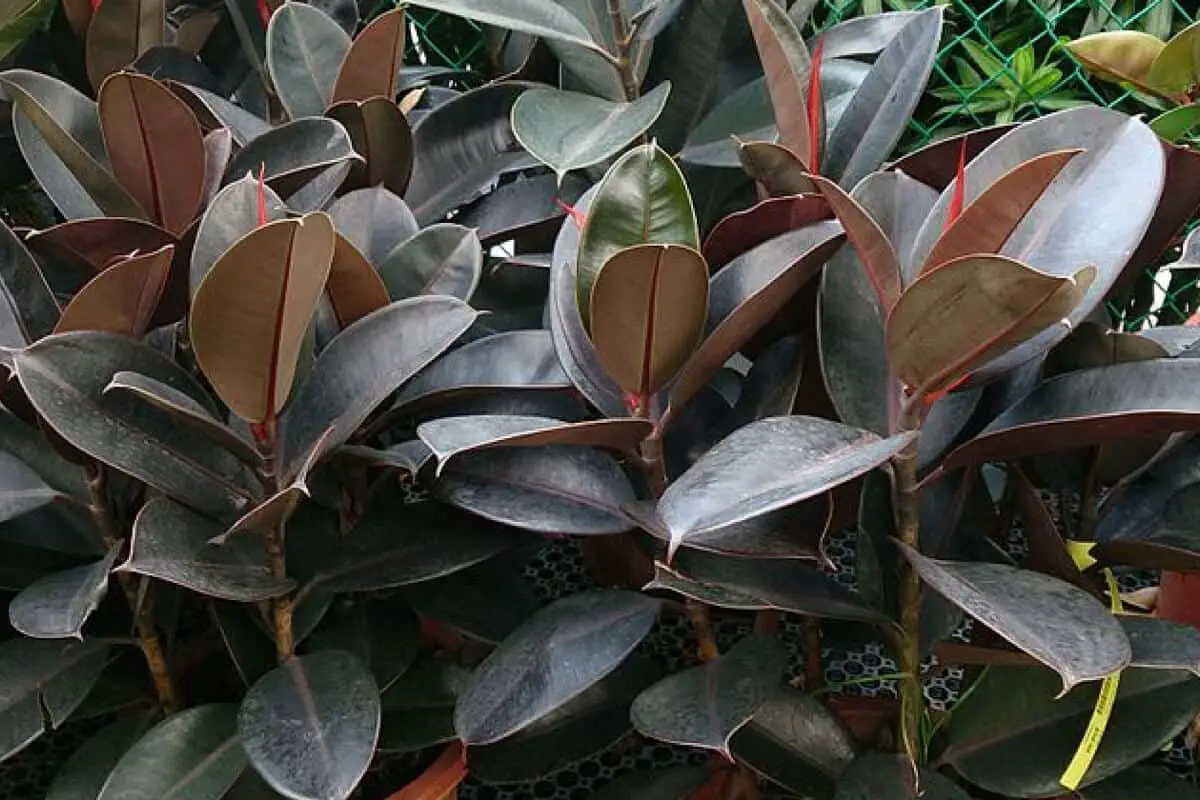
The Ruby Ficus plant has a dark green shade for leaves with red veins; it’s commonly grown as a houseplant, but can also grow into a tree.
Its striking foliage is sure to draw attention, making it perfect for a focal point in the room.
It’s relatively easy to care for and will add a splash of color to any home.
You’ll need to trim the top leaves of this plant, to prevent it from overgrowing.
This plant needs medium to high levels of indirect sunlight and can withstand moderate levels of humidity.
Watering the plant must only be done when the soil on the surface becomes dry so try to avoid overwatering the soil.
12. Aglaonema Siam Aurora (Aglaonema ‘Siam Aurora’)
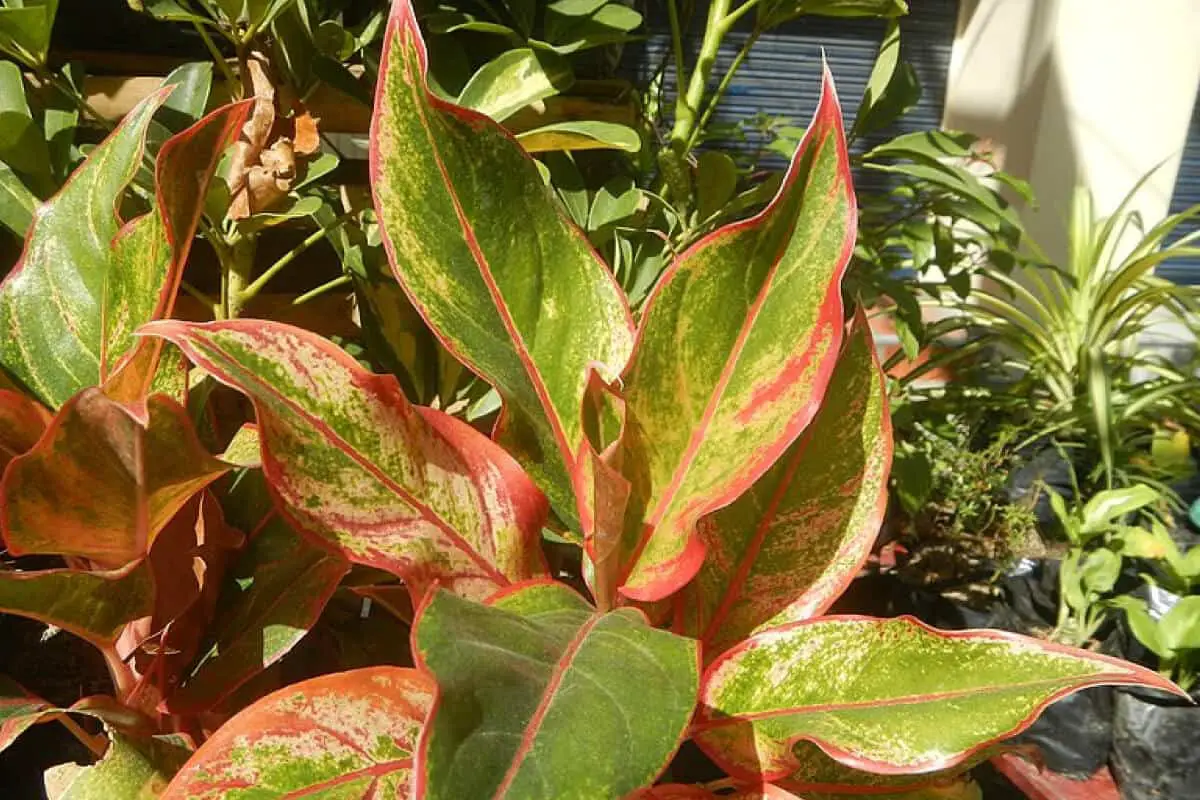
The Aglaonema Siam Aurora is a great choice for creating a lush and vibrant look in your home.
The beautiful color combinations of exotic red and green leaves will be the perfect addition to any houseplant collection.
The Aglaonema Siam Aurora is a perennial tropical plant that will surely brighten up the darkest of rooms.
Temperatures between 65-75°F are ideal for the Aglaonema and it should be kept away from any cold drafts or air-conditioning vents.
Keep it out of direct sunlight as well as it only requires medium light.
The soil should also be kept consistently moist but not wet and fertilized every two weeks with a balanced fertilizer during the summer months and once a month during the winter months.
Prune off dead leaves as needed to keep the plant looking healthy and vibrant.
Lastly, mist your Aglaonema Siam Aurora regularly with lukewarm water to increase humidity levels as these plants prefer high humidity levels.
13. Cordyline Rubra (Cordyline Fruticosa ‘Rubra’)

The Cordyline Rubra is often referred to as the ‘Palm Lily’, and the leaves of this plant have a stunning shade of bronze-green center with a red edging.
The Cordyline Rubra’s foliage with a colorful range of colors will surely add a unique dynamic to your indoor garden!
This plant will grow well in shaded areas around your house, with 4-6 hours of indirect sunlight.
It’s important to keep the temperature warmer as this plant is sensitive to frost.
Water your plant thoroughly but not excessively, allowing the soil to dry out between waterings. During the summer months fertilize once per month using a balanced fertilizer.
Removing dead or yellowing leaves will help keep the plant looking its best and be sure to check for pests such as mealybugs or spider mites.
14. ‘Red Star’ Nerve Plant (Fittonia Albivenis ‘Red Star’)
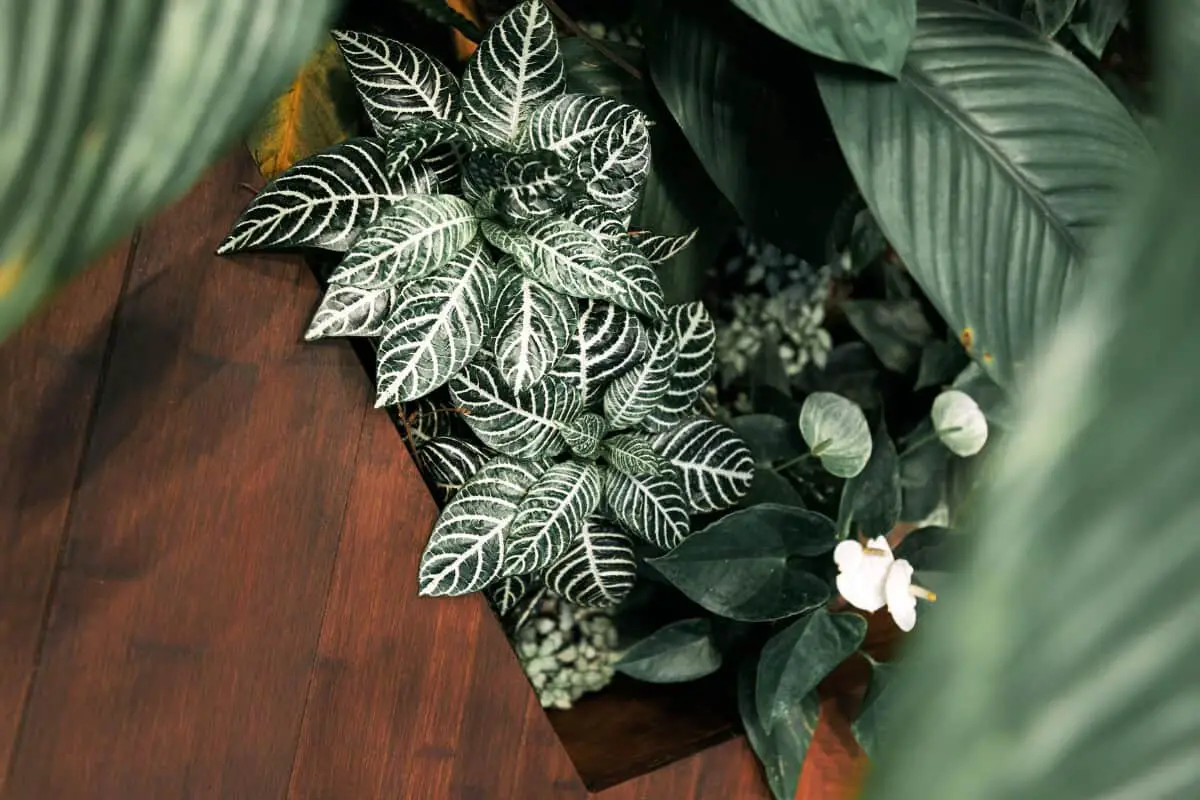
The Red Star Nerve plant is a type of Fittonia with bright red, white, and green leaves. It has striking foliage that stands out from the usual green foliage fittonia plants.
Its leaves are more pointed in shape and it is also more tolerant of lower light levels than other fittonia varieties.
Additionally, the red star nerve plant requires more humidity than other fittonia species and needs to be misted regularly to keep the foliage looking vibrant.
When the plant needs to be watered, its leaves will become droopy. After some rehydration, the plant will quickly regain its stature.
To ensure that the plant keeps its bright red veins, it must be given sufficient indirect lighting as low levels of light will lead to faded levels of color.
Learn more about Caring for Nerve Houseplants.
15. Red Congo Philodendron (Philodendron Rojo Congo)
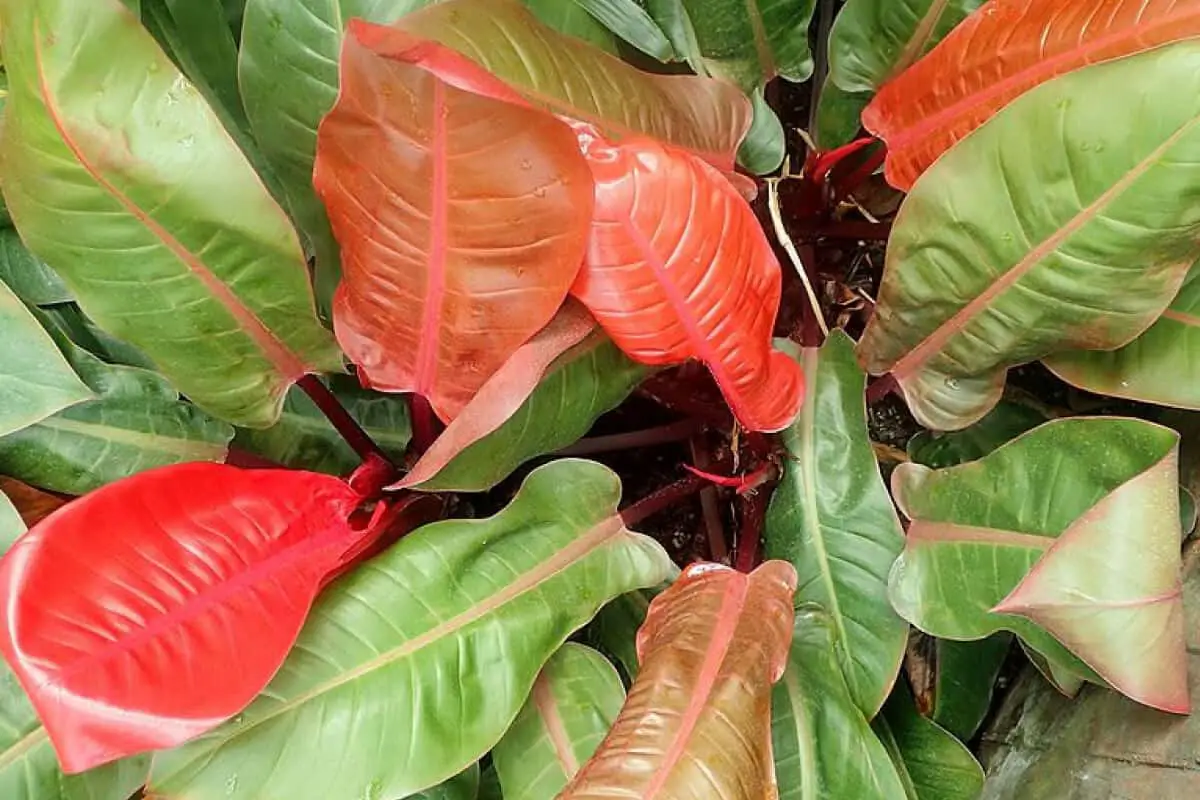
The Red Congo Philodendron is a great choice for anyone looking for an easy-to-care-for houseplant with striking red foliage.
The colorful foliage of reds and greens of this plant provides an eloquent contrast to a white wall, which makes this plant one of the best houseplants to grow.
The Red Congo Philodendron is also one of the easiest indoor plants to take care of—this plant can literally be grown by anyone.
When it comes to water, the Red Congo Philodendron should be watered when the soil is dry.
This plant does not require much fertilizer but applying a balanced fertilizer in spring and summer will keep it looking its best.
The Red Congo Philodendron is best grown in an indirect but bright light but will withstand lower levels of sunlight.
It’s vital that this plant is kept away from direct light as the strong rays from the sun will damage the plant’s leaves.
Read more about different Philodendron varieties.
16. ‘Red Anne’ Nerve Plant (Fittonia Albivenis ‘Red Anne’)
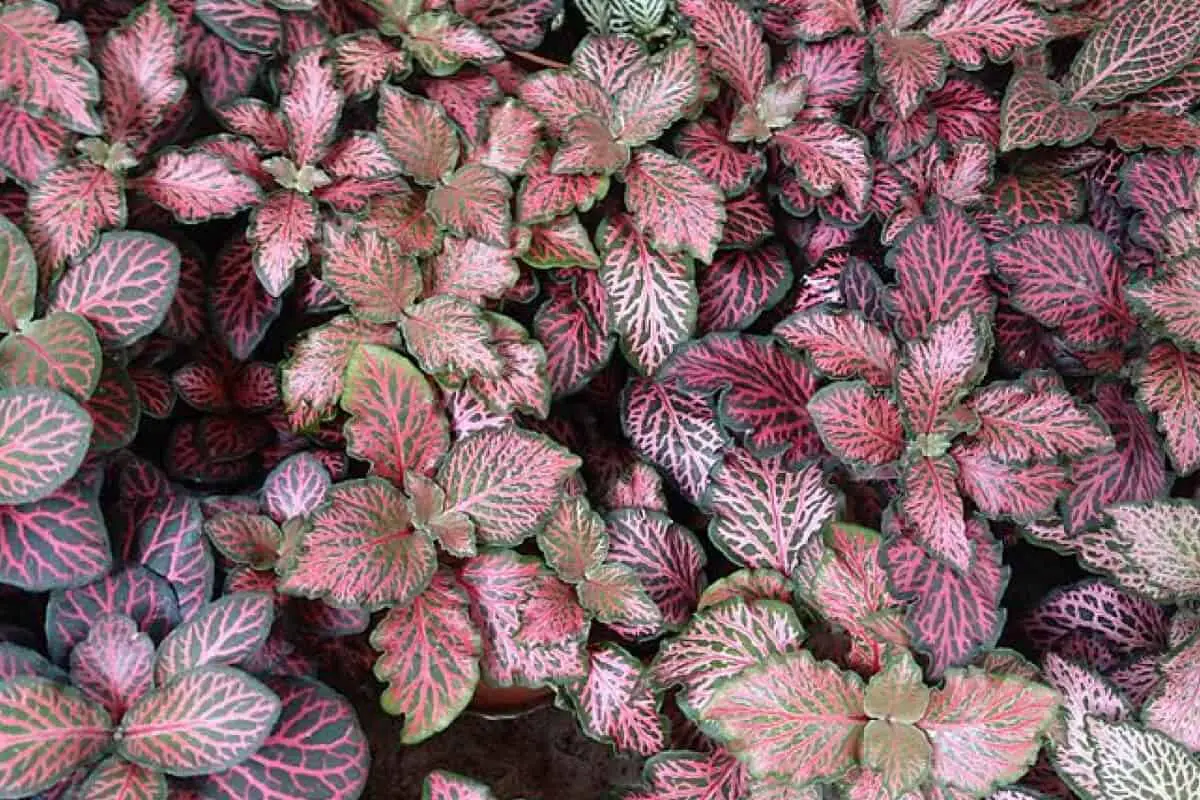
The Red Anne Nerve plant is a smaller indoor plant that is ideal for growing in terrariums. This plant has stunning green leaves that are variegated with red and pink leaf veins.
The main difference between the Red Anne Nerve Plant and other Fittonia albivenis is the bold, bright red veins that run throughout the leaves of the former.
This gives this particular variety a more unique look than other varieties of Fittonia albivenis.
It also requires more humidity to maintain its vibrant coloration than other varieties.
Additionally, it is slightly more tolerant of lower light levels than other Fittonia albivenis plants, making it a better option for low-light environments.
You’ll only need to water the Red Anne Nerve plant when the top surface level of the soil has begun to dry. This plant thrives in soil that is moist but not excessively soggy, so don’t overwater your plants.
17. Red Anjamani (Aglaonema ‘Red Anjamani’)
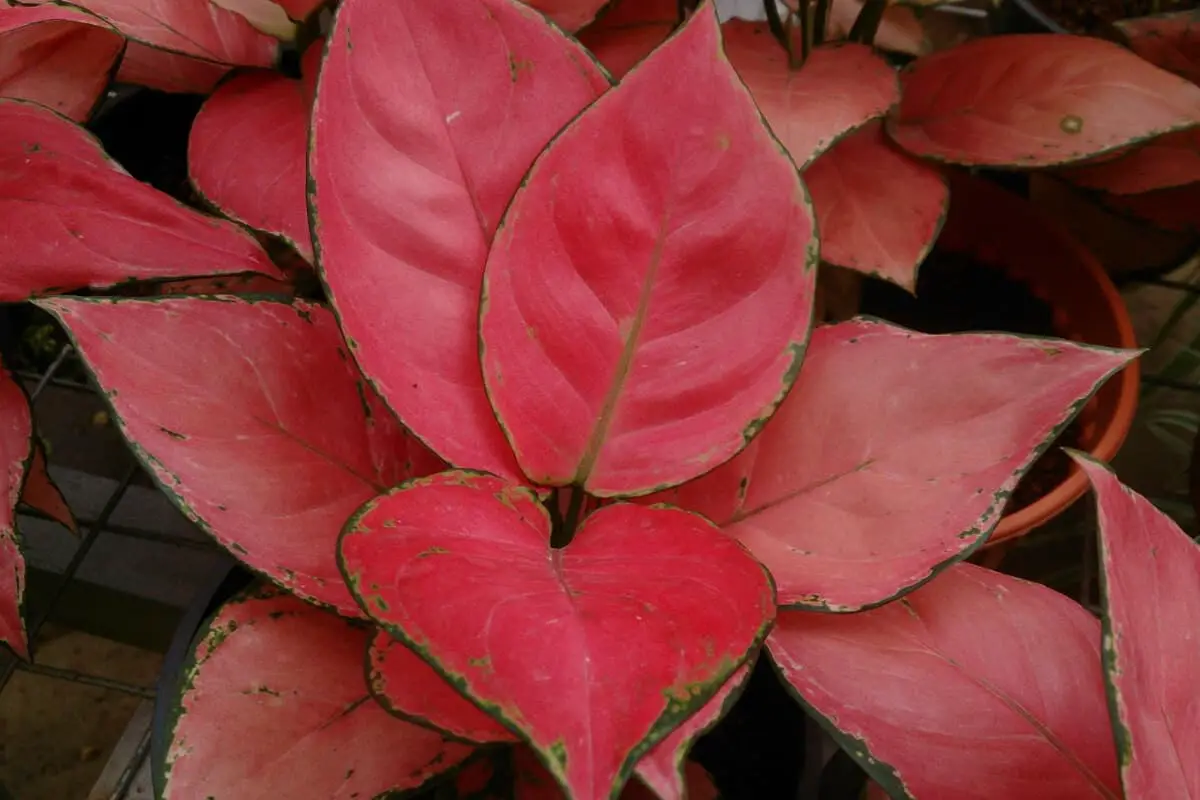
The Red Anjamani is a variety of Aglaonema that boasts bright red foliage. It’s a stunning houseplant with lush, glossy leaves that are variegated with deep red veins.
The main difference between the Aglaonema Valentine and the Red Anjamani is in their leaf shape.
The variegated leaves of the Valentine variety have more pointed tips, while those of the Red Anjamani are more oval-shaped.
Additionally, the Red Anjamani has brighter and more vibrant colors than its counterpart.
The Red Anjamani is tolerant of both wet and dry conditions, and it’s also able to survive in low-light areas.
It’s important to maintain the soil moist without making it too wet. Hydrate the plant when the top layer of soil is dry. Avoid overwatering as this can lead to root rot.
It’s best to apply a balanced fertilizer in spring and summer to keep the plant looking its best.
Lastly, make sure to keep the plant away from direct sunlight as strong rays can damage its leaves.
Final Thoughts on Plants With Red Leaves
Red-leaved plants offer a unique and striking addition to any garden or indoor plant collection.
They can create a bold statement and bring life to any setting with their wide range of colors and vibrant hues.
From the red-veined fittonias to the red aglaonemas, there are a variety of species of plants that can offer red foliage.
Add both beauty and interest to your environment by incorporating these plants into your landscape or home décor.
Consider incorporating red-leaved plants into your collection if you’re looking to add some color and personality to your space!
Check out these amazing articles to learn more about plants:

